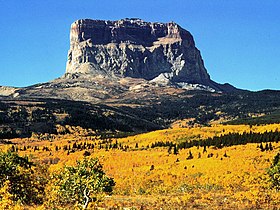Chief Mountain
| Chief Mountain | |
|---|---|

Chief Mountain
|
|
| Highest point | |
| Elevation | 9,080 ft (2,770 m) |
| Prominence | 1,840 ft (560 m) |
| Coordinates | 48°55′58″N 113°36′33″W / 48.9327629°N 113.6092671°WCoordinates: 48°55′58″N 113°36′33″W / 48.9327629°N 113.6092671°W |
| Geography | |
|
|
|
| Parent range | Lewis Range |
| Topo map | USGS Many Glacier |
| Climbing | |
| First ascent | 1892 by Stimson, et al. |
| Easiest route | Climb |
Chief Mountain (also called Old Chief Mountain) is located in the U.S. state of Montana on the eastern border of Glacier National Park and the Blackfeet Indian Reservation. The mountain is one of the most prominent peaks and rock formations along the Rocky Mountain Front, a 200 mi (320 km) long overthrust fault, known as the Lewis Overthrust, which extends from central Montana into southern Alberta, Canada.
The peak is easily seen from Montana and Alberta due to the rapid 5,000 foot (1,524 m) altitude gain over the Great Plains which are immediately east of the mountain. Despite the mountain's being in Montana, the distinctive eastern face quickly becomes hidden as one travels south into Montana, but remains very easy to see on clear days over much of southern Alberta. Hence, many businesses in the area (notably Lethbridge) have "Chief Mountain" in their name. Chief Mountain is one of the most photographed mountains in the region due to its unique nature.
Chief Mountain is an example of a klippe. It consists of a Precambrian block which rests directly above much younger Cretaceous gray shales. Having an older layer (Precambrian in this case) pushed up to the top is typical of thrust faults. The surrounding portion of the thrust sheet has been removed by erosion leaving behind this isolated block of Proterozoic rock.
Chief Mountain has been a sacred mountain to Native American tribes for hundreds of years. The Blackfoot name for the mountain is Nínaiistáko. The mountain was seen by white explorers in the late 18th century and was known as "Kings Peak" on maps produced in the United Kingdom in 1795. Meriwether Lewis, co-leader of the Lewis and Clark Expedition, saw the mountain in 1805 and called it "Tower Mountain". The name was changed in the late 19th century in reflection of Blackfeet naming of the mountain which was "Great Chief". When Glacier National Park was created in 1910, the summit and most prominent eastern slopes of the mountain were located within the park, leaving only the lower slopes within Blackfeet jurisdiction. The northwestern enemy of the Blackfoot, the Nakoda (Stoney), called it also Hũga Baha (″Chief Hill″).
...
Wikipedia

